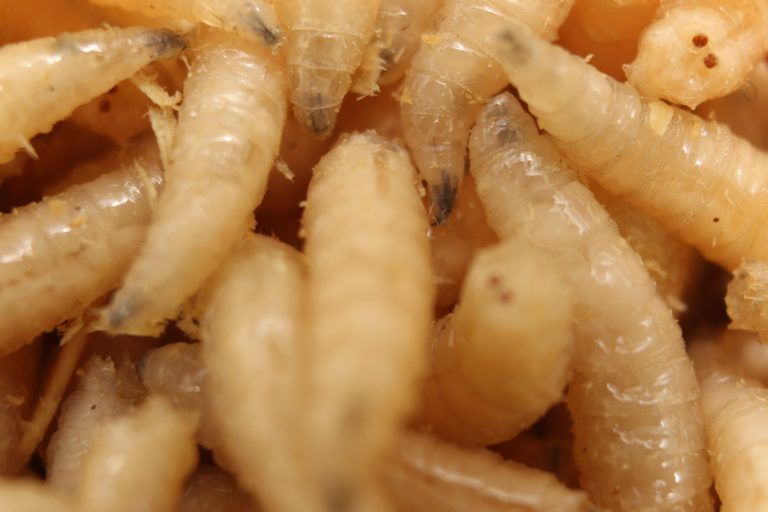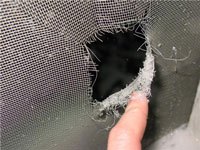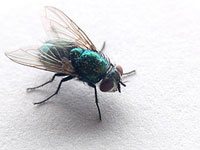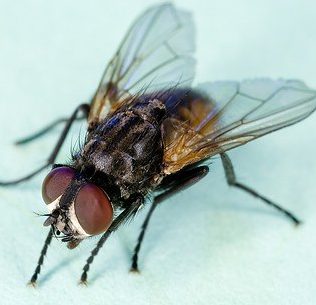
Nothing elicits a blood-curdling scream and chills up and down the spine like the discovery of a maggot infestation. Not unlike politicians, maggots are mostly white, they hang around trash, and sometimes they feed on the blood of the innocent. Unlike politicians, though, you can get rid of maggots without spending a lot of cash…and they’re sometimes useful.
There are actually many different kinds of maggots, but they all come from the order Diptera (flies). Maggots are fly larvae, so you probably, but not necessarily, noticed flies before you found the maggots. Certain flies, like the screw worm fly and certain kinds of botfly are flesh eaters and will prey on pets, livestock, and yes, even people. Don’t rush to burn your house down just yet – these kinds of maggot infestations are rare. What you’re probably dealing with is a more common (housefly), symbiotic kind of maggot. These maggots know how busy you are, and they just want to help you get rid of that rat that chose to die inside your wall.
If the maggots are fat and juicy (around 6mm long) they are probably looking for a nice cozy place to pupate, and then turn into a fly, and then help you with that garbage you’ve neglected to take care of. Okay, okay, let’s cut to the chase and get rid of those maggots.
Maggots: To kill or not?
Let’s start with a fundamental question: Do you want to kill the maggots, or do you simply want to not have them in your environs any longer?
Some people see a maggot — or a cockroach or mouse for that matter — and simply say: “I want it gone, and if that means we kill it, then we kill it.”
Others see these little invaders and their heart tells them to give it a peaceful exit somehow, allowing it to live. Keep in mind — the full lifespan of that maggot might only be a month — 5 or so days in its current form, and then maybe another 15-30 days as a fly. But still, we know a lot of people who simply don’t want to exterminate other creatures.
The tips we have in this piece include a combination of “kill” and “no-kill” solutions for the maggot. If you are a pacifist and come across some extermination advice, simply skip to the next tip.
Best Ways to Get Rid of Maggots

Killing them with boiling water is a cheap, chemical-free way to get rid of maggots.
It may seem a bit Dark Ages, reminiscent of dumping tar from the battlements, but it kills maggots instantly. This method is perfect for trash cans, garbage bins, and crawl spaces – or really anywhere you have a writhing pile of maggots. I would avoid using this method on carpet or in walls unless you have a quick method to get rid of the moisture, as this could lead to mold and structural damage in your home.
Also be careful of using this method on plastic — such as those hard, plastic trash bins. Plastic melts at 338 degrees farenheit, which means that if you toss boiling water in a plastic bin, it needs to be at the low-end of the boiling point — just above 212.
Obviously, be very careful when handling boiling water, and be sure there are no kids or pets nearby when you attempt this method. It works, but take precautions and do it at your own risk. Consider this a disclaimer — a tiny mishap and the boiling water could be seriously burning your skin.
Best to use a long-handled pot or pan, along with plenty of protection like a long-sleeve shirt (or two), closed-toed shoes, and a big old oven mitt.

For the karma-conscious who think boiling maggots is cruel (c’mon, they’re fly larvae), using the freezer is a painless way to get rid of maggots.
Simply collect the maggots, seal them in a plastic bag, and then throw them in the freezer. They will die peacefully in their sleep. Later, you can toss them out in the trash without worrying about them crawling away to launch another maggot infestation. I like to label the maggot container just so nobody makes the critical mistake of confusing it with some kind of human food. If the maggot problem is small and you have a sealing dumpster, just put them in a bag and toss them. Maggots are decomposers – let them do their job at the dump.

If you get rid of the maggots’ natural habitat, you’ll get rid of maggots.
Rotting food and any leftover meat products should be sealed in bags or frozen until garbage day. If you have trash bins inside, opt for one with a tight-sealing lid. The fact is that maggots are composters — and they serve a purpose of digesting nasty trash. You will often find that maggots can actually make trash smell better, because they eat the worst of it.
Still, we understand if you do not want to be the host to a maggot colony.
Emptying and washing trash bins regularly is a good idea, as the odor of anything decaying will attract flies. If you have children or pets, extra vigilance is needed; little Timmy may think the closet is a good place for that unwanted drumstick, and cats love to bring their kills into the home. Above all, strive to maintain a clean home.
Be especially vigilant with vegetables and fruit. That old banana that someone leave’s in a corner, or the old lettuce or broccoli that makes its way into a garbage but no further, both can really attract maggots. Some speculate that it is the alcohol that develops (like fermenting) in old, aging fruit and vegetables that attracts maggots and other bugs, like fruit flies.

Intensifying homeland security goes a long way in preventing maggot infestations.
The concept is simple: If you can keep any living things (except for humans) out of your home, you are less likely to have issues with everything from maggots to mice.
You should make sure all of your windows, doors, and screens are in good repair. Keep drains clean by using an organic drain cleaner. Also, check for any openings in your foundation and unscreened vents outside your home. Inspect your yard and any brush or compost piles for dead animals or rotting matter that have attracted maggots/flies. If you or anyone near you is using poison to get rid of a rodent problem, it will greatly increase your chances of having a maggot infestation, as animals search for secure hiding places when they are sick.
Likewise, if you are attempting to kill mice or rats with poison traps, beware. The rodent will die somewhere unknown, and the maggot will find it and feast on it. The bacteria-infested corpse is a perfect food source for the typical maggot.

If you want to get rid of the maggots, you’re going to have to kill their parents.
I don’t mind a little violence where pest control is concerned, so I opt for a fly swatter. In my hands, it is a perilous weapon, and the splatter makes for a cheap Rorschach test. If the fly problem is significant enough to warrant pesticides or fly traps, be aware that different methods work for different kinds of flies. To learn more about fly control, read this compelling article.
If you Live on a Farm, Stay Extra Clean
If you are someone who might live on a farm, or raise backyard chickens or other animals, be sure to take extra steps to reduce the amount of dirt of manure you bring in the house with you. Maggots love manure. You will often find them in an area with horses, cows, chickens, etc. You just need to be sure that your clothing and footwear does not drag that stuff in with you.
If you or a child has a horse hobby, keep those boots clean and preferably outdoors.
Farmers, farm families, and horse enthusiasts are a big part of America’s soul. But that trace of manure that you bring inside with you is a perfect place for a maggot, and the fly that lays the egg can smell that stuff from a long ways away.
Best Maggot Control Products
Safe Solution’s Enzyme Cleaner.
A biodegradable, non-toxic, biological type of pest control that uses a maggot’s (or any insect’s) own biology against it. A maggot secretes an enzyme that helps it unzip its exoskeleton so it can grow. When maggots come into contact with the solution that contains the enzyme, their exoskeleton pops off prematurely. Without armor, they either dry out or are killed by other ingredients in the solution. Enzyme cleaners such as these have a bright future. You can get Safe Solutions TweetMint Cleaner in concentrate form from Amazon
Use a self-sealing garbage bin.
It’s a great way to prevent having to get rid of maggots in the first place. A lot of homes I visit have open garbage bins or ones that are “missing” the lid. While this may be convenient for you, it is doubly-so for maggots.
Keep in mind that maggots arrive because of flies. Flies can get in and deposit their eggs, and then the maggots can sometimes escape to pupate elsewhere in your home. Getting a garbage bin with a pedal will also limit the spread of germs and save you a few hand washings…if you do that sort of thing.
We especially like the one from Simple Human — sturdy, sealing, and attractive. They make them in a few different sizes to. Check them out on Amazon.
Use a Beer Trap.
Beer traps are a great way to attract and then kill maggots in a problem area. Simply set out a lamp and an easy-to-access dish of beer. The maggots will crawl in and drown in the booze. If I were a maggot, this is the way I’d want to be killed.
Alternative ways to get rid of maggots
- Sweep the maggots into a pile and place a newspaper on top. Dance wildly on the newspaper. Try an Irish jig or, if you’re uncoordinated, just march in place.
- A practical way to get rid of maggots is by feeding them to chickens or taking them with you fishing. Fish go nuts for maggots. Maggots love dead fish…the circle of life.
- Sarcasm, though unproven, is a method I use for getting rid of maggots. “Oh sure, feel free to just squirm around. Can I get you anything? Perhaps a festering carcass is in order?”
Using Chemicals to Kill Maggots: Permethrin and Pyrethrum
I tend to avoid using chemicals whenever I can, but if you have a massive or hard-to-reach maggot infestation, they are a viable way to get rid of the problem. If you’ve found this article, chances are you’ve already tried a pesticide or two which were met by maggot laughter. For maggots, by far the most popular agent of destruction is a chemical called permethrin. It is in many products, from Pledge to animal shampoo, and of course pesticides. Pesticides containing permethrin are sometimes touted as safe and green, but don’t be fooled; all pesticides are at least mildly toxic. Pyrethrum is another option. Pyrethrum is made from certain types of chrysanthemum, which is what makes the flower such a mainstay around gardens. It comes in sprays and powders, and for severe, out-of-reach maggot infestations can be used with foggers. Used in moderation, both these chemicals are credible ways to get rid of maggots. You can find them on Amazon, like this one from Southern Ag.
Note — do not use pyrethrin or permethrin around bees. These chemicals kill bees, and we like bees. Use sparingly, do not put them on outdoor plants. Pyrethrin and permethrin should be used in a targeted fashion. Think like a surgeon, not a crop duster.
Why we need not kill all the maggots
The use of maggots to treat wounds has been around for centuries. Though their value seems to be remembered and then forgotten, maggot therapy is currently on the upswing; certain kinds of maggots have been used by doctors to kill bacteria and heal wounds that modern laser technology and antibiotics could not. Researchers in the UK are currently working to develop a new super antibiotic from an enzyme in the secretions of bottle fly maggots that promises to eliminate the much-feared MRSA infection. When confronted with the horror of a maggot infestation, the diabolical mind’s (yes you) first inclination is “I’m going to get rid of every last maggot.” Well, maggots are essential creatures. In the end, that dead moose isn’t going to eat itself, is it?
Maggots can actually do something that has been confounded humans for centuries, too. They can make your garbage smell good! We understand why you might not like having maggots around, but consider letting these little composters do their job!
Finally, maggots are a go-to live bait for fishing enthusiasts in many parts of the country. A large maggot — or wax worm — is one of the best lures for certain species of freshwater fish such as perch and panfish. If you enjoy your fresh fish, know that they might be available to you because of a role that maggots played somewhere along the way.
Maggot FAQs

Where do Maggots Come From?
Maggots come from flies! Flies lay eggs that become maggots. It is a swift lifecycle. The maggot / fly combo can have as many as 12 generations in a year, with a couple hundred maggots in each hatch.
What Do Maggots Eat?
The nastier, the better for maggots. Maggots eat food and other organic matter, like mammal carcasses and dead flesh. They also eat each other in some situations! Maggots are not afraid of god-awful, rotten, stinky food, and they are fine feasting on an animal corpse that most humans couldn’t get near due to the smell.
Maggots tend to be especially attracted to rotting fruits and vegetables, but anything is fair game.
Can Maggots Be Helpful?
Yes, maggots can be quite helpful. They are great composters, because of their ability to eat through food sources and basically cleanse them. They are great in a compost pile of old, rotting food. In fact, hunters and taxidermists often use maggots to chew the organic matter off of large game skulls, leaving a neat, white skeleton that can be displayed.
Medically, maggots are very effective at eating away dead, rotting flesh, and have actually been used to stave off infection and disease in people who have bone infections.
Maggots make excellent freshwater fishing bait.
Can Maggots Be Harmful?
Besides being a bit repulsive, and invasive, there are some problems that maggots can carry with them. Maggots in the Galapagos are actually causing issues with some speciies of birds, as they attack newly hatched birds, killing them and then eating the flesh.
Maggots are more good than bad, but like with anything, nothing is 100% virtuous.